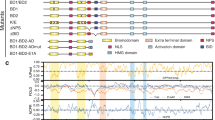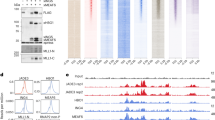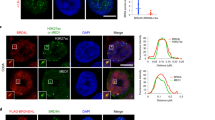Abstract
Bromodomain protein 4 (BRD4) is a chromatin-binding protein implicated in cancer and autoimmune diseases that functions as a scaffold for transcription factors at promoters and super-enhancers. Although chromatin decompaction and transcriptional activation of target genes are associated with BRD4 binding, the mechanisms involved are unknown. We report that BRD4 is a histone acetyltransferase (HAT) that acetylates histones H3 and H4 with a pattern distinct from those of other HATs. Both mouse and human BRD4 have intrinsic HAT activity. Importantly, BRD4 acetylates H3 K122, a residue critical for nucleosome stability, thus resulting in nucleosome eviction and chromatin decompaction. Nucleosome clearance by BRD4 occurs genome wide, including at its targets MYC, FOS and AURKB (Aurora B kinase), resulting in increased transcription. These findings suggest a model wherein BRD4 actively links chromatin structure and transcription: it mediates chromatin decompaction by acetylating and evicting nucleosomes at target genes, thereby activating transcription.
This is a preview of subscription content, access via your institution
Access options
Subscribe to this journal
Receive 12 print issues and online access
$189.00 per year
only $15.75 per issue
Buy this article
- Purchase on Springer Link
- Instant access to full article PDF
Prices may be subject to local taxes which are calculated during checkout








Similar content being viewed by others
Change history
22 July 2016
In the version of this article initially published, the blots in Figure 2c were inadvertently replaced with a duplicate of the blots in Figure 2b. The error has been corrected in the HTML and PDF versions of the article.
References
Wu, S.Y. & Chiang, C.M. The double bromodomain-containing chromatin adaptor Brd4 and transcriptional regulation. J. Biol. Chem. 282, 13141–13145 (2007).
Dey, A. et al. A bromodomain protein, MCAP, associates with mitotic chromosomes and affects G2-to-M transition. Mol. Cell. Biol. 20, 6537–6549 (2000).
Floyd, S.R. et al. The bromodomain protein Brd4 insulates chromatin from DNA damage signalling. Nature 498, 246–250 (2013).
Dey, A., Nishiyama, A., Karpova, T., McNally, J. & Ozato, K. Brd4 marks select genes on mitotic chromatin and directs postmitotic transcription. Mol. Biol. Cell 20, 4899–4909 (2009).
Kadauke, S. & Blobel, G.A. Mitotic bookmarking by transcription factors. Epigenetics Chromatin 6, 6 (2013).
Mochizuki, K. et al. The bromodomain protein Brd4 stimulates G1 gene transcription and promotes progression to S phase. J. Biol. Chem. 283, 9040–9048 (2008).
Wu, S.Y., Lee, A.Y., Lai, H.T., Zhang, H. & Chiang, C.M. Phospho switch triggers Brd4 chromatin binding and activator recruitment for gene-specific targeting. Mol. Cell 49, 843–857 (2013).
You, J. et al. Regulation of aurora B expression by the bromodomain protein Brd4. Mol. Cell. Biol. 29, 5094–5103 (2009).
Lovén, J. et al. Selective inhibition of tumor oncogenes by disruption of super-enhancers. Cell 153, 320–334 (2013).
Chiang, C.M. Brd4 engagement from chromatin targeting to transcriptional regulation: selective contact with acetylated histone H3 and H4. F1000 Biol. Rep. 1, 98 (2009).
Devaiah, B.N. et al. BRD4 is an atypical kinase that phosphorylates serine2 of the RNA polymerase II carboxy-terminal domain. Proc. Natl. Acad. Sci. USA 109, 6927–6932 (2012).
Devaiah, B.N. & Singer, D.S. Cross-talk among RNA polymerase II kinases modulates C-terminal domain phosphorylation. J. Biol. Chem. 287, 38755–38766 (2012).
Struhl, K. Histone acetylation and transcriptional regulatory mechanisms. Genes Dev. 12, 599–606 (1998).
Fukuda, H., Sano, N., Muto, S. & Horikoshi, M. Simple histone acetylation plays a complex role in the regulation of gene expression. Brief Funct. Genomic. Proteomic. 5, 190–208 (2006).
Sterner, D.E. & Berger, S.L. Acetylation of histones and transcription-related factors. Microbiol. Mol. Biol. Rev. 64, 435–459 (2000).
Kouzarides, T. Chromatin modifications and their function. Cell 128, 693–705 (2007).
Strahl, B.D. & Allis, C.D. The language of covalent histone modifications. Nature 403, 41–45 (2000).
Dey, A., Chitsaz, F., Abbasi, A., Misteli, T. & Ozato, K. The double bromodomain protein Brd4 binds to acetylated chromatin during interphase and mitosis. Proc. Natl. Acad. Sci. USA 100, 8758–8763 (2003).
Tropberger, P. & Schneider, R. Scratching the (lateral) surface of chromatin regulation by histone modifications. Nat. Struct. Mol. Biol. 20, 657–661 (2013).
Tropberger, P. et al. Regulation of transcription through acetylation of H3K122 on the lateral surface of the histone octamer. Cell 152, 859–872 (2013).
Nicodeme, E. et al. Suppression of inflammation by a synthetic histone mimic. Nature 468, 1119–1123 (2010).
Nishiyama, A., Dey, A., Miyazaki, J. & Ozato, K. Brd4 is required for recovery from antimicrotubule drug-induced mitotic arrest: preservation of acetylated chromatin. Mol. Biol. Cell 17, 814–823 (2006).
Kruhlak, M.J. et al. Regulation of global acetylation in mitosis through loss of histone acetyltransferases and deacetylases from chromatin. J. Biol. Chem. 276, 38307–38319 (2001).
Zhao, R., Nakamura, T., Fu, Y., Lazar, Z. & Spector, D.L. Gene bookmarking accelerates the kinetics of post-mitotic transcriptional re-activation. Nat. Cell Biol. 13, 1295–1304 (2011).
Wang, R. & You, J. Mechanistic analysis of the role of bromodomain-containing protein 4 (BRD4) in BRD4-NUT oncoprotein-induced transcriptional activation. J. Biol. Chem. 290, 2744–2758 (2015).
Dutnall, R.N., Tafrov, S.T., Sternglanz, R. & Ramakrishnan, V. Structure of the histone acetyltransferase Hat1: a paradigm for the GCN5-related N-acetyltransferase superfamily. Cell 94, 427–438 (1998).
Filippakopoulos, P. et al. Selective inhibition of BET bromodomains. Nature 468, 1067–1073 (2010).
Vernarecci, S., Tosi, F. & Filetici, P. Tuning acetylated chromatin with HAT inhibitors: a novel tool for therapy. Epigenetics 5, 105–111 (2010).
McBrian, M.A. et al. Histone acetylation regulates intracellular pH. Mol. Cell 49, 310–321 (2013).
Zheng, Y., Thomas, P.M. & Kelleher, N.L. Measurement of acetylation turnover at distinct lysines in human histones identifies long-lived acetylation sites. Nat. Commun. 4, 2203 (2013).
Devaiah, B.N. & Singer, D.S. Two faces of brd4: mitotic bookmark and transcriptional lynchpin. Transcription 4, 13–17 (2013).
Baranello, L. et al. RNA Polymerase II regulates Topoisomerase 1 activity to favor efficient transcription. Cell 165, 357–371 (2016).
Delmore, J.E. et al. BET bromodomain inhibition as a therapeutic strategy to target c-Myc. Cell 146, 904–917 (2011).
Zhang, W. et al. Bromodomain-containing protein 4 (BRD4) regulates RNA polymerase II serine 2 phosphorylation in human CD4+ T cells. J. Biol. Chem. 287, 43137–43155 (2012).
Wang, R., Li, Q., Helfer, C.M., Jiao, J. & You, J. Bromodomain protein Brd4 associated with acetylated chromatin is important for maintenance of higher-order chromatin structure. J. Biol. Chem. 287, 10738–10752 (2012).
Jones, M.J. & Jallepalli, P.V. Chromothripsis: chromosomes in crisis. Dev. Cell 23, 908–917 (2012).
Liu, W. et al. Brd4 and JMJD6-associated anti-pause enhancers in regulation of transcriptional pause release. Cell 155, 1581–1595 (2013).
Devaiah, B.N. et al. Novel functions for TAF7, a regulator of TAF1-independent transcription. J. Biol. Chem. 285, 38772–38780 (2010).
Berndsen, C.E. & Denu, J.M. Assays for mechanistic investigations of protein/histone acetyltransferases. Methods 36, 321–331 (2005).
Mizzen, C.A. et al. The TAF(II)250 subunit of TFIID has histone acetyltransferase activity. Cell 87, 1261–1270 (1996).
Kotekar, A.S., Weissman, J.D., Gegonne, A., Cohen, H. & Singer, D.S. Histone modifications, but not nucleosomal positioning, correlate with major histocompatibility complex class I promoter activity in different tissues in vivo . Mol. Cell. Biol. 28, 7323–7336 (2008).
Nagarajan, S. et al. Bromodomain protein BRD4 is required for estrogen receptor-dependent enhancer activation and gene transcription. Cell Rep. 8, 460–469 (2014).
Chapuy, B. et al. Discovery and characterization of super-enhancer-associated dependencies in diffuse large B cell lymphoma. Cancer Cell 24, 777–790 (2013).
Langmead, B. & Salzberg, S.L. Fast gapped-read alignment with Bowtie 2. Nat. Methods 9, 357–359 (2012).
Cui, K. & Zhao, K. Genome-wide approaches to determining nucleosome occupancy in metazoans using MNase-Seq. Methods Mol. Biol. 833, 413–419 (2012).
Li, H. Aligning sequence reads, clone sequences and assembly contigs with BWA-MEM. Preprint at http://arxiv.org/abs/1303.3997 (2013).
Chen, K. et al. DANPOS: dynamic analysis of nucleosome position and occupancy by sequencing. Genome Res. 23, 341–351 (2013).
Wei, G., Hu, G., Cui, K. & Zhao, K. Genome-wide mapping of nucleosome occupancy, histone modifications, and gene expression using next-generation sequencing technology. Methods Enzymol. 513, 297–313 (2012).
Trapnell, C., Pachter, L. & Salzberg, S.L. TopHat: discovering splice junctions with RNA-Seq. Bioinformatics 25, 1105–1111 (2009).
Deng, X. SeqGene: a comprehensive software solution for mining exome- and transcriptome- sequencing data. BMC Bioinformatics 12, 267 (2011).
Acknowledgements
We thank D. Levens, E. Harlow, R. Sen and L. Staudt for critical reading of the manuscript and members of the Singer laboratory for discussions. We are especially grateful to K. Placek and K. Zhao for their technical assistance with the RNA-seq experiments. We thank M. Zhou for the mass spectrometry analysis and the NIH CIT/Biowulf cluster used in the analyses of the ChIP-seq data. This research was supported by the Intramural Research Program of the NIH, National Cancer Institute, Center for Cancer Research.
Author information
Authors and Affiliations
Contributions
B.N.D. performed the experimental work, and C.C.-B. performed microscopy analysis and Brd4fl/fl MEF analysis. A.G. generated and isolated BRD4-KO thymocytes and performed FACS analysis. B.N.D. and D.S.S. designed experiments, analyzed results and wrote the manuscript. A.D. and K.O. generated the Brd4fl/fl mice. C.H.H., Q.C. and D.M. performed whole-genome sequence analysis and statistics.
Corresponding author
Ethics declarations
Competing interests
The authors declare no competing financial interests.
Integrated supplementary information
Supplementary Figure 1 BRD4 has intrinsic HAT activity.
(a) BRD4 trans-acetylates histone H3 and H4 peptides. Quantitation of relative acetylation in filter binding HAT assays done with either 250ng BRD4 either by itself or with 100ng histone H3 (1-21 aa) or H4 (1-21 aa) peptides.
(b) BRD4 auto-acetylates. Autoradiograph showing auto-acetylation of 500ng BRD4 subjected to a HAT assay with radiolabeled acetyl CoA. The expected migration position of BRD4 is marked with an arrow.
(c) BRD4 preferentially acetylates histones H3.1 and H3.3 among the three H3 isoforms. Autoradiograph showing 1µg H3.1, H3.2, or H3.3 subjected to HAT assays with or without 500ng BRD4 (upper panel). Relative acetylation of the three histones was quantified (lower panel). Background acetylation of histones in absence of enzyme is due to spontaneous reaction of AcCoA with lysine residues as shown previously (Berndsen, C.E. & Denu, J.M. Methods 36, 321-31 (2005)).
(d) BRD4 preferentially acetylates histones H1.0. Autoradiograph showing 1µg H1.0 and H1.4 subjected to HAT assays with or without 500ng BRD4. Coomassie stained gel shows equal loading of histone H1 (lower panel). Uncropped images of gels and immunoblots are shown in Supplementary Data Set 1.
Supplementary Figure 2 BRD4 acetylates histones in vivo, and acetyl CoA improves BRD4 binding to histones.
(a) Blocking of BRD4 binding to chromatin reduces histone acetylation genome-wide. Metagene analysis of ChIP-seq data showing TSS-associated BRD4, total H3ac and H4ac following treatment of LPS stimulated bone marrow-derived macrophages with 5 µM of iBET or DMSO (right panels), TSS-associated BRD4 and H3K27ac following treatment of diffuse large B cell lymphoma cells (LY1) with 500nM JQ1 or DMSO (left panels).
(b) BRD4 functions as a HAT in multiple human and murine cell types. H3ac histone immunoblots of whole cell extracts (WCE) cultured for 16, 18 and 20h in the presence of sodium butyrate after transfection of human U2OS osteosarcoma, DLD-1 colorectal adenocarcinoma or MCF-7 breast adenocarcinoma cells with 3µg pCMV2 vector (control) or hBRD4. Similar immunoblots were done for WCEs of murine NIH3T3 and kidney cells transfected with 3ug pCDNA vector (control) or BRD4.
(c) BRD4 binding to unacetylated histone H3 is enhanced in the presence of AcCoA. Immunoblot shows histone H3 (1µg input), that was incubated for 30 minutes with or without AcCoA under HAT assay conditions, bound by 600ng BRD4. BRD4 immunoblot shows BRD4 on nickel-NTA beads.
Uncropped images of immunoblots are shown in Supplementary Data Set 1.
Supplementary Figure 3 BRD4 HAT activity is distinct from that of other HATs.
(a) BRD4 HAT activity is inhibited by the small molecule JQ1 in the absence of bromodomains. Ac-histone H3 immunoblot showing 1µg histone H3 subjected to a HAT assays with 500ng BRD4 or the BRD4 mutant deleted of both bromodomains (BRD4 ΔB1B2) in the presence or absence of 100μM JQ1.
(b and c) BRD4 exhibits different acetylation kinetics with specific lysine residues. Immunoblots, as indicated, of HAT assays done for increasing time with either 1μg histone H3 or H4 in the presence of 500ng BRD4. Total histone H3 or H4 immunoblots show equal loading of histones in the reaction.
(d) BRD4 preferentially acetylates histone H3 that is pre-acetylated at H3K14 lysine. 10 ng H3K14ac peptide, H3K9ac peptide or control non-acetylated H3 (1-21 aa) peptide, were used in HAT assays with 150 ng BRD4 for increasing periods of time and immunoblotted with an antibody cocktail containing anti-H3K4ac and H3K18ac. Acetylation pattern of each peptide was quantified and plotted against time (lower panel); error bars represent ±s.e.m., n=3 three independent experiments.
(e) BRD4 HAT activity is enhanced at higher pH. Immunoblots, as indicated, of HAT assays done with 500ng BRD4 and 1μg histone H3 in reaction buffers with pH 6.5, 7.0, 7.5, 8.0, 8.5 and 9.0.
Uncropped images of immunoblots are shown in Supplementary Data Set 1.
Supplementary Figure 4 BRD4 acetylates H3K122 independently of p300/CBP.
(a) BRD4 acetylates histone H3 tail lysines and H3K122. Graph summarizes the mass spectrometric mapping of acetylated peptides from 1µg human histone H3.3 acetylated by either 600ng BRD4 or an equimolar amount of p300. The X-axis indicates specific acetylated lysines; Y-axis shows the number of peptides detected bearing these acetylated lysines.
(b) H3K122ac depends on BRD4 HAT activity in primary mouse kidney cells or NIH3T3 cells. Immunoblots as indicated, of WCE made 18hr post-transfection from mouse kidney cells or NIH3T3 cells transfected with 3µg pCDNA vector (control) or FLAG-tagged BRD4 and BRD4 HAT mutants in the presence of sodium butyrate (The ∆60AA mutant lacks a FLAG tag)
(c) Curcumin inhibits p300, but not BRD4, acetylation of H3K122. Immunoblots, as indicated, showing 1µg histone H3 subjected to HAT assays with or without (mock) 500ng BRD4 or 750ng p300 in the presence or absence of 50μM curcumin.
(d) H3K122ac, H3K18ac and H3K27ac levels are affected by JQ1 inhibition of endogenous BRD4 in vivo. Immunoblots, as indicated, of WCEs from control, non-BRD4 transfected U2OS cells treated with JQ1 (250 and 500nM) or equal volume of DMSO (-) for 18hr. WCEs were loaded at three times (60 µg) the quantity used in Fig. 4h, Lanes 1-3.
Uncropped images of immunoblots are shown in Supplementary Data Set 1.
Supplementary Figure 5 BRD4 acetylation of H3 K122 is distinct and leads to decreased nucleosome occupancy genome wide.
(a) BRD4 acetylates H3K122 independent of p300/CBP. Immunoblots, as indicated, of WCE from U2OS cells transfected with either control siRNA or p300 and CBP siRNAs, which were further treated with 500nM JQ1 or DMSO.
(b) Meta-analysis of genome-wide co-localization of H3K122ac with the binding sites of BRD4, p300, CBP, CTCF, MYC and Gata3. Aggregation plot shows the mean tag count in MCF-7 cells for H3K122ac at the peak binding sites of each of the factors.
(c) Comparative genome-wide nucleosome occupancy at regions upstream and downstream of TSS. Quantitated from MNase-seq data in Fig. 6A. Error bars represent ± s.e.m. n=6 technical replicates from two independent experiments. p values, by two-tailed student’s t-test.
Uncropped images of immunoblots are shown in Supplementary Data Set 1.
Supplementary Figure 6 BRD4 HAT activity affects RNA Pol II levels at the TSSs of BRD4-target genes.
ChIP of Pol II occupancy around the TSS of the MYC, AURKB and AURKA genes in U2OS cells transfected with 3µg hBRD4, hBRD4 HAT mutant or pCMV2 vector control in the presence of sodium butyrate. The transfected cells were treated with either 500nM JQ1 or an equal volume of the DMSO vehicle for 18hr prior to the ChIP-qPCR. Error bars represent ± s.e.m.; n = 4 technical replicates from two independent experiments (p<0.05 based on two-tailed student’s t-tests).
Supplementary Figure 7 Characterization of BRD4-KO MEFs.
BRD4fl/- MEFs deleted of BRD4 by Cre and simultaneously rescued with exogenous WT and mutant BRD4 have levels of BRD4 comparable to those in the parental BRD4fl/- MEFs. Anti-BRD4 immunoblots of WCE made from parental BRD4fl/- and MEFs deleted of BRD4 and rescued with either WT BRD4 or Mt BRD4. Tubulin immunoblots shows equal loading of the WCE’s.
Uncropped images of immunoblots are shown in Supplementary Data Set 1.
Supplementary information
Supplementary Text and Figures
Supplementary Figures 1–7 and Supplementary Tables 1 and 2 (PDF 1324 kb)
Supplementary Data Set 1
Original uncropped images of gels, autoradiographs and blots (PDF 4414 kb)
Source data
Rights and permissions
About this article
Cite this article
Devaiah, B., Case-Borden, C., Gegonne, A. et al. BRD4 is a histone acetyltransferase that evicts nucleosomes from chromatin. Nat Struct Mol Biol 23, 540–548 (2016). https://doi.org/10.1038/nsmb.3228
Received:
Accepted:
Published:
Issue Date:
DOI: https://doi.org/10.1038/nsmb.3228
This article is cited by
-
PROTAC’ing oncoproteins: targeted protein degradation for cancer therapy
Molecular Cancer (2023)
-
BRD4 is involved in viral exacerbation of chronic obstructive pulmonary disease
Respiratory Research (2023)
-
Single-cell trajectory analysis reveals a CD9 positive state to contribute to exit from stem cell-like and embryonic diapause states and transit to drug-resistant states
Cell Death Discovery (2023)
-
BRD9-mediated chromatin remodeling suppresses osteoclastogenesis through negative feedback mechanism
Nature Communications (2023)
-
Bromodomain and extraterminal (BET) proteins: biological functions, diseases, and targeted therapy
Signal Transduction and Targeted Therapy (2023)



